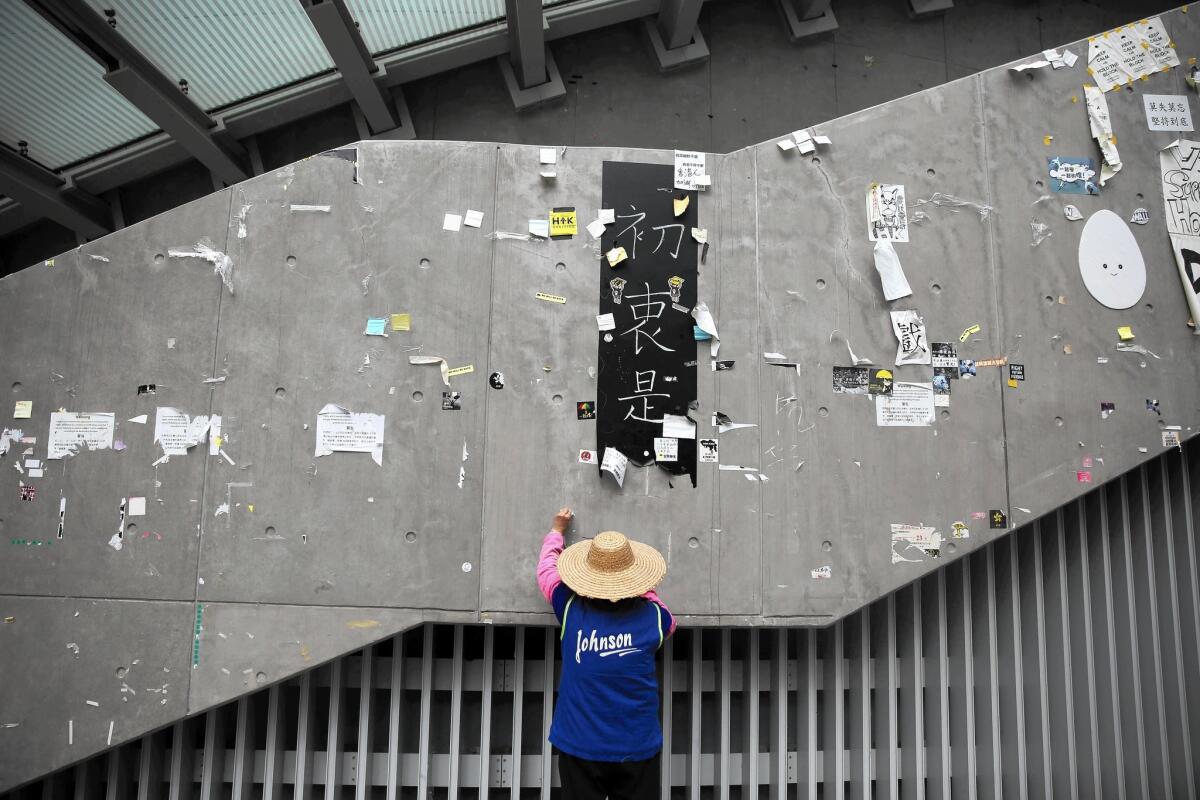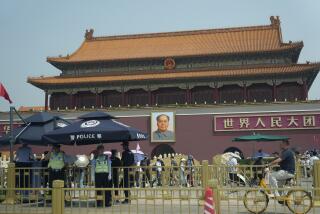Hong Kong protesters seek to archive their art, words for posterity

A worker cleans up an area of the main pro-democracy protest site in the Admiralty district of Hong Kong on Dec. 12.
Reporting from Hong Kong — After a demonstration site here was forcibly cleared by police in late November, work crews swooped in to sweep away the detritus of dissent. A postal carrier quickly applied a fresh coat of emerald green paint on a mailbox. Any trace of the protest fliers once plastered on it was all but obliterated.
“Don’t ever underestimate the ability of a tyranny to whitewash history,” says Wen Yau, an artist and art researcher who co-founded an archiving group to document the cornucopia of artworks created during Hong Kong’s pro-democracy movement.
Called Umbrella Movement Visual Archives & Research Collective, the group grew to more than 100 volunteers within three weeks after its mid-October founding.
The explosion of creativity and ingenuity on display at protest sites has meant they have their work cut out for them.
Look no further than the “Umbrella Man” standing tall and defiant outside the government office complex: a 9-foot-tall sculpture made of discarded wood blocks attached to a metal frame under a quilt of torn umbrellas — remnants of a clash between unarmed protesters and tear-gas-bomb-throwing police. Not every artifact was as eye-catching, but that doesn’t mean they weren’t worthy of archiving.
So night after night for the last two months, the volunteers combed through the protest zones for noteworthy objects. After several weekly powwows, a roster of items targeted for salvage and preservation were selected, based on their historical and aesthetic value.
Late last Wednesday, the night before police had been expected to clear the Admiralty protest site, the collective’s salvage teams worked under dim street light to catalog protest fliers and drawings before wrapping them in cling film. A larger-than-life color pencil sketch of the city’s much-maligned chief executive proved a bit tricky to handle by a lone volunteer. Ditto for the 10-row triangular stack of intact eggshells facing a fake brick wall made out of foam.
Ordinary citizens, mostly supporters of the movement, have also taken it upon themselves to record and preserve items that embody their cause, a sea change from the past, when Denny Ho was researching his doctoral thesis in the 1990s on local protests over the decades. Ho had difficulty tracking down any documents or artifacts.
Although the city’s museum officials have ruled out collecting anything derived from illegal protests, Ho is confident that this time around, oblivion is not an option.
“The onus is on grass-roots groups to record the history of their social movements,” said Ho, now a professor of applied social science at Hong Kong Polytechnic University. “Besides, there’s always a struggle between the grass roots and the government in the interpretation of history.”
Protesters in Hong Kong, a former British colony that returned to Chinese rule in 1997 under a framework known as “one country, two systems,” began demonstrating in late September to demand open nominations of candidates for the chief executive election in 2017. China’s central government in Beijing has instead insisted that all candidates be approved by a committee made up largely of business leaders and other pro-establishment figures.
The protests, led mostly by university students, have seen tens of thousands of people occupy Hong Kong thoroughfares. But most of the protest sites, including the main one surrounding government headquarters, were cleared out by police last week.
Simon Chu, a professional archivist who once headed the city’s government records office, has asked the government to guarantee there’ll be no destruction of records related to the movement. So far, the appeal has gone unanswered.
Chu lamented that except for replicas of the Goddess of Democracy statue that stand tall on several college campuses in Hong Kong, banners and artworks from the 1989 Tiananmen Square pro-democracy movement in Beijing are all but forgotten. Chu, however, feels encouraged by the current grass-roots archiving efforts.
The collective thus far has been able to find a temporary home in a private cultural institution for salvaged items, and there’s significant interest from overseas museums. Some Occupy items are included in an exhibit called Disobedient Objects at the Victoria and Albert Museum in London. The collection will tour Australia and Chile next year. In Hong Kong, at least one university archive says it would open its doors.
“If our students brought their records to us, then we would be interested in having them,” said Stacy Lee, chief archivist of the University of Hong Kong.
After midnight Thursday, a dozen volunteers sprang into action to preserve the Lennon Wall Hong Kong when it became apparent that the structure, unlike its namesake in Prague, the Czech Republic, would be destroyed by authorities.
The wall was a rainbow of Post-it notes, exhibiting the hopes of pro-democracy supporters. The entire outdoor spiral stairway of the government office compound was papered over.
Volunteers, some recruited by Ronald Wong, a college student who spearheaded the effort to preserve the wall, gingerly peeled off each note by hand. Last month, the wall had been recorded with a high-definition camera by a college student so it could be reconstructed sometime somewhere. Until then, some of the posted aspirations would be packed away.
“Committed citizens can always change the world!”
“I want to vote for someone I want, not someone chosen by CHINA!”
Even in the race against time, every piece counts, Wong said.
“That’s because every one of these notes bears witness to the idea behind this movement.”
Law is a special correspondent.
More to Read
Sign up for Essential California
The most important California stories and recommendations in your inbox every morning.
You may occasionally receive promotional content from the Los Angeles Times.










